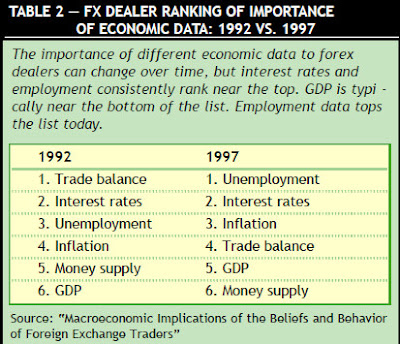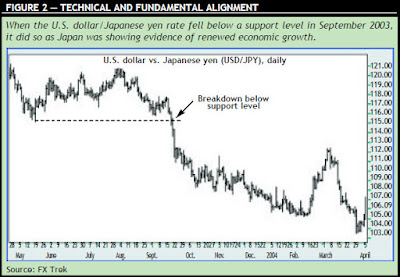What makes currencies tick? Find out which economic factors help shape the short-term and long-term forex landscape .
The
stock market has traditionally received the lion’s share of attention
in the trading industry, but foreign currency (forex) trading has surged
in recent years. Forex’s 24-hour access, liquidity and high leverage
has attracted many active traders. Intraday traders can respond
immediately to breaking news and events, thus avoiding having to wait
for the market to open and risk “paying the gap.”
Because of
regulations, capital requirements and technology, access to the forex
market was traditionally restricted to hedge funds, large commodity
trading advisors (CTAs) and institutional investors. However, in recent
years many firms have s p rung up to offer forex trading to retail
traders.
The growth in this area of the trading industry has been
very rapid, especially as equity and futures traders realize the
approaches they’ve been using for years in their respective markets —
particularly price-based techniques based on technical and quantitative
analysis — are equally applicable to forex.
From a price-action
perspective, currencies rarely spend much time in tight trading ranges
and tend to develop strong trends. More than 80 percent of currency
trading volume is speculative in nature and, as a result, the market
frequently overshoots and then corrects.
Also, many of the
macroeconomic catalysts and events traders use in the equity or futures
markets — including gauging interest-rate changes and economic releases —
are also integral to forex trading. In addition, price moves in many
commodities or indices are highly correlated to currency moves. For
example, Australia is the world’s third - largest gold producer, which
explains the Australian dollar’s 80-percent positive correlation with
gold prices. As a result, many commodity traders can trade forex to
spread their risk or leverage certain positions.
The most actively
traded currency pairs are, in order, the euro currency / U.S. dollar
(EUR/USD), British pound/U.S. dollar (GBP/USD), U.S. dollar/Japanese yen
(USD/JPY) and the U.S. dollar/Swiss franc (USD/CHF). Table 1 shows the
historical trading ranges of these and other currency pairs over the
past one and five years.
Fundamentals for long-term trading
Fundamental
analysis focuses on the economic, social and political forces that
drive supply and demand. More so than other markets, currencies tend to
develop strong trends, and one of the key roles of fundamental analysis
is forecasting longterm trends. Analysts consider various macroeconomic
indicators, such as economic growth rates, interest rates, inflation and
employment when forecasting the markets. Fundamental drivers of
currency moves include economic data releases, interest rate decisions,
news and announcements, all of which can indicate potential changes in
the economic, social and political environment.
Fundamental
analysis helps determine whether currencies a re undervalued or
overvalued. A classic example is the eurocurrency/dollar rate (EUR/USD),
which has been in a long-term uptrend since 2002 (see Figure 1). This
trend can be explained by the ballooning U.S. account deficit, the U.S.
government’s flagging commitment to a strong dollar and the fragile
nature of the labor market recovery.
An example of a popular
fundamental-based trading strategy is the “carry trade,” which exploits
the interest rate differential between currencies. This was a primary
driver of exchange rate movements in 2002 and 2003. The strategy
consists of going long a currency with a high interest rate while
simultaneously going short a currency with a low interest rate with the
goal of earning both the yield differential (the difference between the
interest rates of the two countries), as well as capital appreciation.
This type of strategy re w a rded currency traders who went long the
Australian dollar against the U.S. dollar in 2003 with a 30-percent
gain.
Fundamentals for short-term trading: Trading off economic releases
While
many participants in the forex market are pure technicians, a 1999
study (“Macroeconomic Implications of the Beliefs and Behavior of
Foreign Exchange Traders,” www.nber.org/papers/w7417) involving U.S.
foreign exchange dealers revealed a significant number of traders also
used a fundamental- based approach. Nearly one-fourth of dealers
surveyed claimed they primarily used fundamental methods to trade, vs.
30 percent who used technical analysis. It should not be surprising,
then, that fundamental data releases impact currency rates in the near
term.
What is more interesting is the speed with which exchange
rates adjust to news. Based on responses from foreign exchange dealers,
the same study found the time it takes for exchange rates to adjust
after data releases , such as unemployment, trade balances,
inflation, GDP and interest rates, is generally less than one minute,
and in many instances less than 10 seconds. The one economic report that
stood apart was money supply, which was estimated to have a longer
exchange rate adjustment time.
The changing importance of different economic statistics
Because
of their strong link to currency value, interest rates consistently
rank among the highest in importance with foreign exchange dealers.
Other data, such as unemployment, trade balances and inflation, tend to
vary in their importance to dealers over time (see Table 2).
Intuitively,
this finding makes sense as the market shifts its attention to diff e
rent economic sectors and data — for example, trade balances may take
precedence when a country is thought to be running unsustainable
deficits. Similarly, in an economy that has difficulty creating jobs,
the market will place greater emphasis on employment data. The top four
entries from 1992 and 1997 shown in Table 2 still head the list today,
with the unemployment / payrolls being the leading market mover.
Interestingly,
according to the survey, some of the least relevant data to foreign
exchange dealers was GDP. One possible explanation is GDP releases are
less frequent than other data used in the study (quarterly vs. monthly).
Also, GDP data is more prone to ambiguity and misinterpretation. For
example, surging GDP brought about by rising exports will be positive
for the home currency; however, if GDP growth is a result of inventory
buildup, the effect on the currency may actually be negative.
The
implication of these findings is twofold. First, because the currency
exchange rate adjustment to economic news tends to be so swift, any
reaction beyond a 15-30 minute window after data is released may be the
result of investor over-reaction or trading related to customer flow
rather than news alone. Second, it is critical to stay abreast of which
data the market deems important at any point in time. Because the
market’s focus changes from period to period, previously relevant data
may end up having less (or more) of an effect on currency values.
The price side of the coin
In
a way, fundamental factors supply the road map of what happens in the
forex market. Navigating that map — that is, actually trading — is
usually a matter of analyzing price action, especially for short-term
traders.
The FX market is well-suited to price-based techniques
such as technical and quantitative analysis. In terms of trading with
technical analysis, as long as you use charts and indicators, trading
the euro currency/dollar currency pair is just like trading shares of
Microsoft or E-mini futures.
One of the most common gripes about
technical analysis is that it fails to consider the very factors that
result in the move - ment of exchange rates; it only looks at statistics
and patterns, which are derivatives of market activity, not causes of
it. As a result, some argue technical analysis is an ineffective
forecasting tool.
Although this is undeniably true, it is also
misleading. The advantage of technical analysis and other price-based
techniques is they do not involve forecasting or predicting — they
consider only what is actually going on in the market regarding
who is buying and who is selling. This is the true information in the
market, and it is the only information that matters. The market is
simply a battle between buyers and sellers — and thus, technical
analysis reasons, looking at the statistics behind this “battle” is all
that is really needed to determine what really is going on in the
market, and how to profit accordingly.
Implications for currency trading
Ultimately,
the most successful trading scenarios tend to be the ones supported by
both technical/quantitative and fundamental arguments. A great example
of this is the breakdown of the dollar against the yen in October 2003 —
the pair declined 6 percent between October 2003 and February 2004 (see
Figure 2).
At that time, both technicals and
fundamentals called for gains in the yen against the dollar.
Technically, the dollar/yen had broken below longer-term support (a
price level that has acted as a floor to past price declines), while
fundamentally, Japan was finally showing economic growth after 10 years
of stagnation.
It is important traders consider both schools of
thought when trading currencies as fundamentals can shift the technical
trend, while technicals can be used to forecast short-term movements.
Tags
Forex Articles





Post a Comment